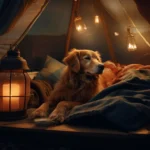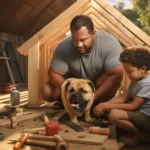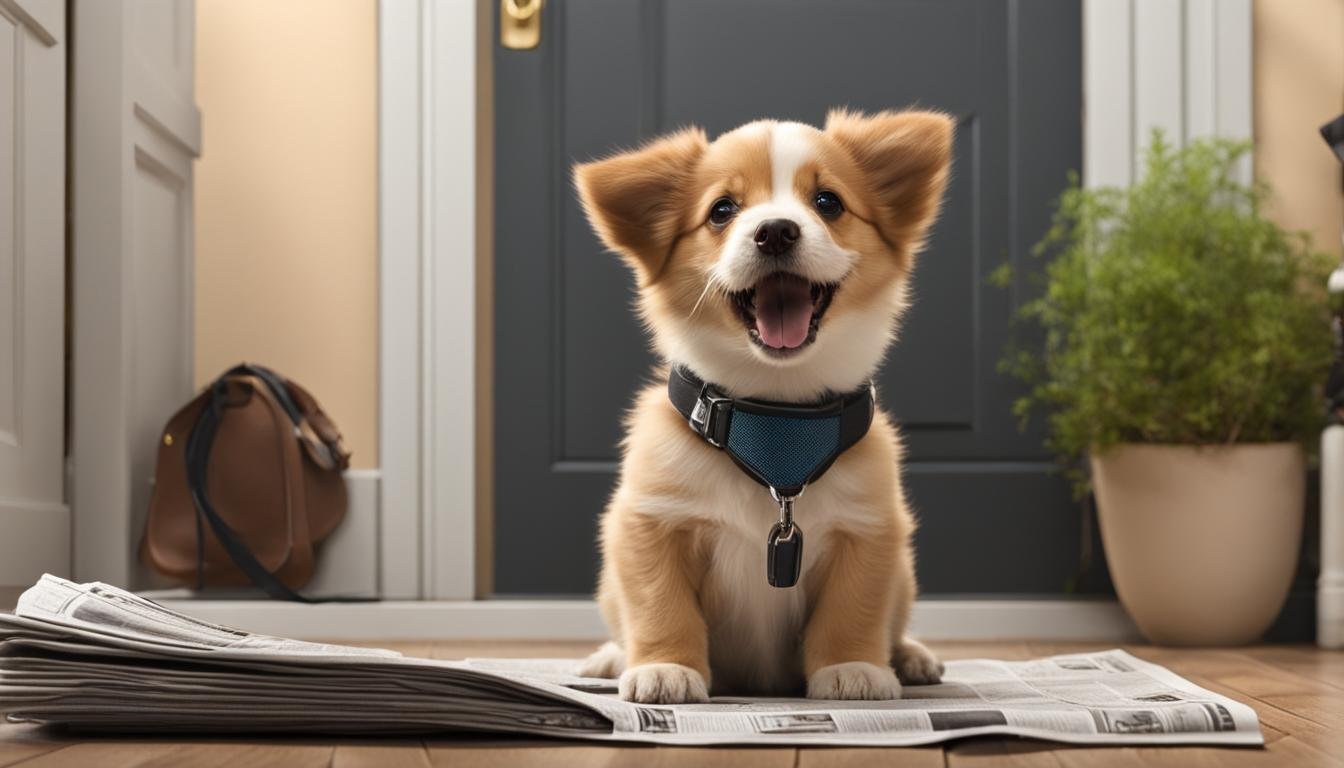Potty training a puppy can be a challenging process, but it is possible to do it without using a crate. This guide will provide you with effective methods and strategies for house training your puppy without a crate. By following these tips, you can achieve successful puppy house training without the need for a crate.
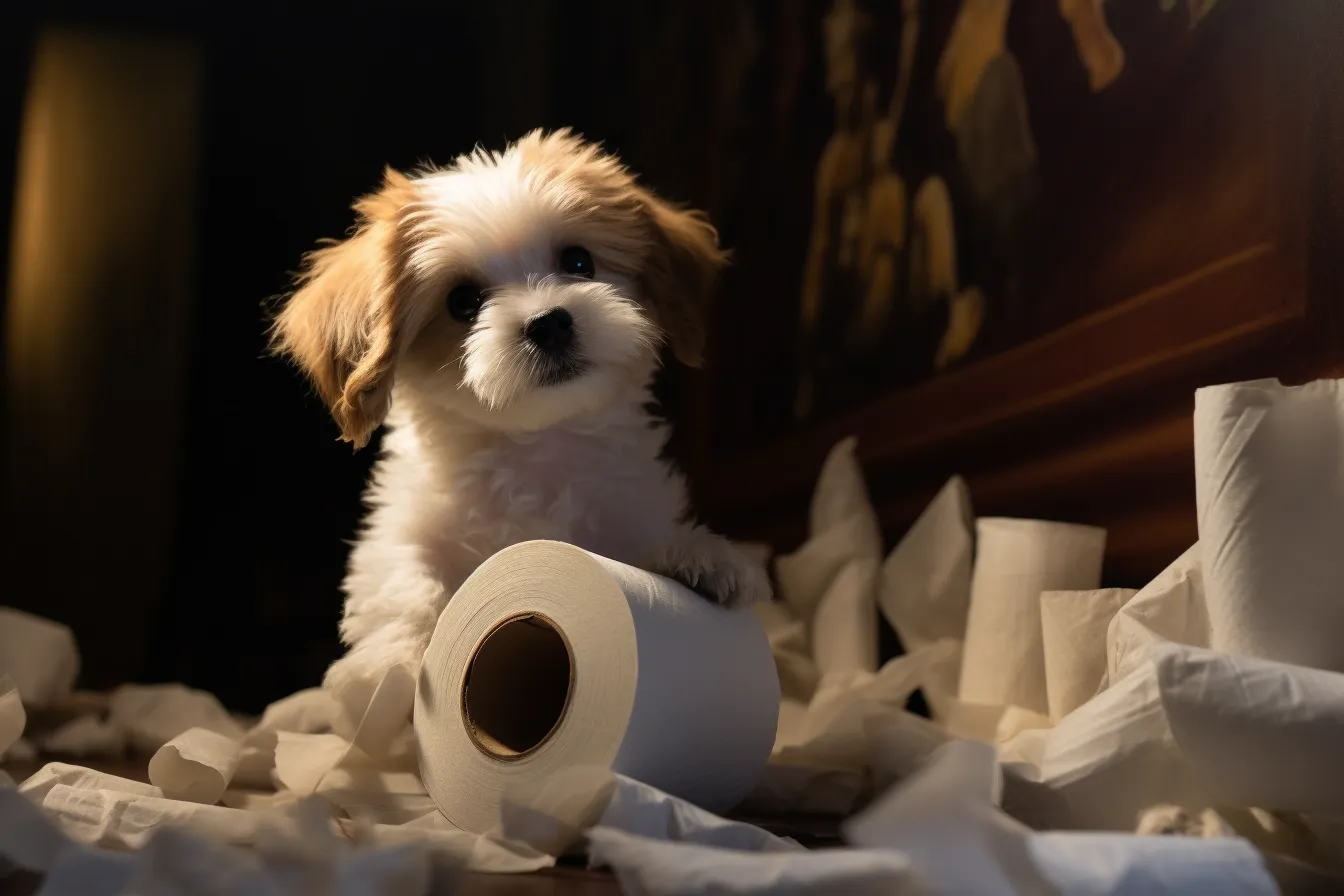
Key Takeaways:
- House training a puppy without a crate is achievable with the right strategies and commitment.
- Opting for crate-free puppy house training offers convenience and more freedom for your puppy.
- Prepare your home by puppy-proofing it and establishing a consistent feeding schedule.
- Schedule regular potty breaks and observe your puppy for potty cues.
- Take your puppy outdoors to a designated potty spot and use positive reinforcement.
Why Choose Crate-Free Puppy House Training?
When it comes to house training a puppy, crate training is often the go-to method. However, there are alternative approaches to puppy house training that can be just as successful without the use of a crate. Opting for crate-free puppy house training offers several advantages that may make it a better fit for you and your furry friend.
One of the main benefits of crate-free puppy house training is the convenience it provides. With crate training, you need to constantly supervise your puppy when they’re inside the crate. However, with a crate-free approach, you can allow your puppy to have a bit more freedom and roam around your home. This can make the training process easier and less restrictive for both you and your puppy.
Another advantage of crate-free puppy house training is the cost-saving aspect. When you choose crate training, you’ll need to invest in a crate, which can be an additional expense. By opting for a crate-free approach, you can save money and still effectively train your puppy to use the designated potty area.
“Crate-free puppy house training allows your puppy to have more freedom and space to roam and bond with you.”
Finally, crate-free training gives your puppy the opportunity to bond with you on a deeper level. When you allow your puppy to be outside of the crate, they have more opportunities for interaction and socialization with you. This can strengthen the bond between you and your puppy, making the training process more enjoyable for both of you.
With these advantages in mind, crate-free puppy house training can be a viable and successful alternative to traditional crate training methods. The next section will provide detailed guidance on how to prepare your home for crate-free puppy house training.
Prepare Your Home for Crate-Free Puppy House Training
Prior to starting crate-free puppy house training, it is essential to prepare your home accordingly. By puppy-proofing your living space, you can create a safe environment for your furry friend while minimizing the risk of accidents. Here are some crucial steps to follow:
Remove Potential Hazards
- Keep shoes, wires, and other chewable items out of your puppy’s reach.
- Securely store cleaning products, medications, and any toxic substances.
- Close off access to rooms or areas that are not puppy-friendly.
Eliminate Previous Potty Spots
“Ensuring that previous potty spots are thoroughly cleaned and neutralized is key to preventing your puppy from revisiting those areas.”
Use an enzymatic cleaner to remove any lingering odors, as dogs have a remarkable sense of smell and may be drawn back to those spots. By eliminating the scent, you’ll encourage your puppy to use the designated potty area you establish.
Secure Your Living Space
- Temporarily remove rugs or mats that may be confused as acceptable potty spots.
- Relocate indoor plants that may entice your puppy to dig or chew.
- Use baby gates to block off areas where you don’t want your puppy to have access.
Designated Potty Area
Set up a specific area in your yard for your puppy’s potty needs. This will help them understand where they should eliminate and make the training process more efficient. Consider using potty pads or a designated patch of grass. Consistency is key, so always bring your puppy to this area during potty breaks.
Summary
Puppy-proofing your home is a crucial step in crate-free puppy house training. By removing potential hazards, eliminating previous potty spots, and securing your living space, you can create a safe environment for your puppy to learn and thrive. Establishing a designated potty area will guide your puppy’s understanding of where they should go, making the house training process smoother and more successful.
| Hazards to Remove | Steps to Take |
|---|---|
| Shoes, wires, and chewable items | Keep them out of your puppy’s reach |
| Cleaning products, medications, and toxic substances | Securely store them |
| Rooms or areas that aren’t puppy-friendly | Close off access |
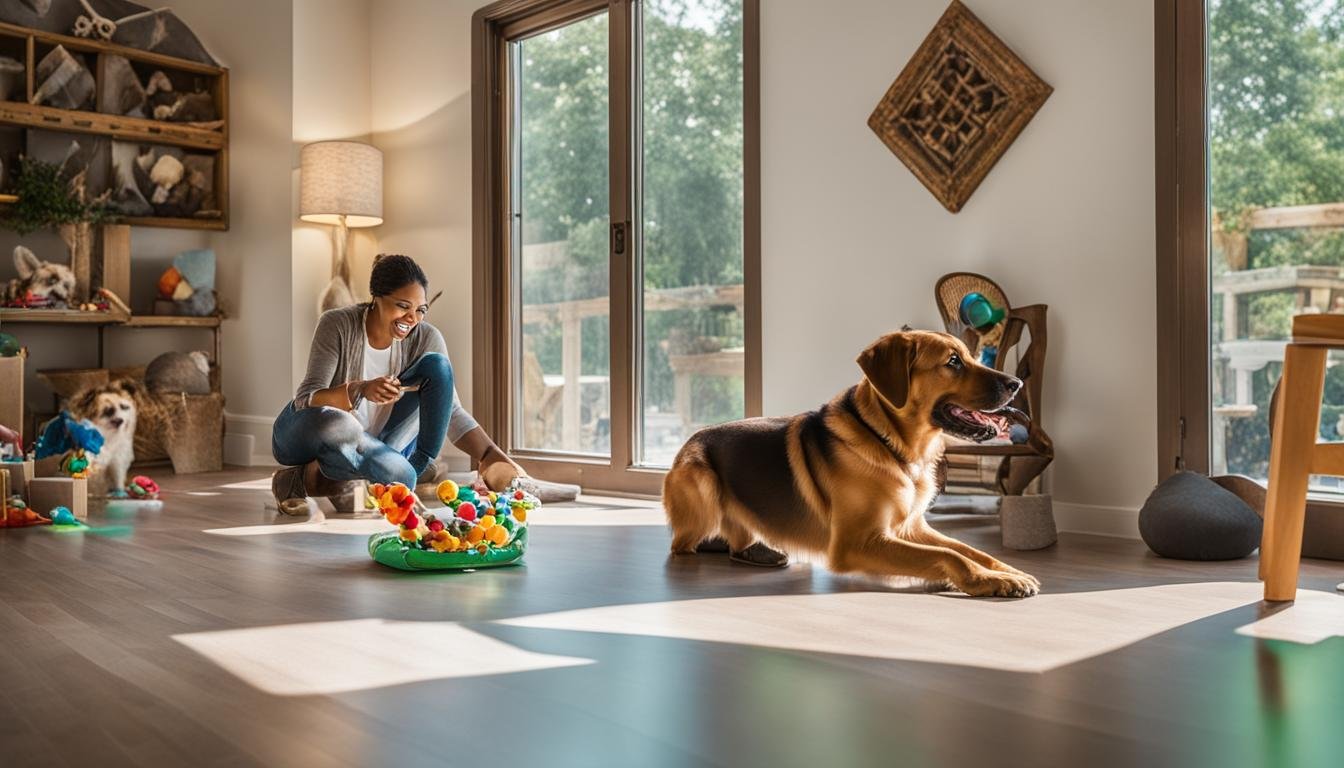
Establish a Consistent Feeding Schedule
Creating a consistent feeding schedule is essential when house training a puppy without a crate. By feeding your puppy at the same times each day, you can establish a routine that helps regulate their digestion and bathroom habits. Aim to feed your puppy at least three meals a day to ensure they are receiving proper nutrition and to prevent overeating. This consistent schedule will make it easier for you to predict when your puppy will need to go potty and plan accordingly.
When determining the amount of food to give your puppy, consider their age, size, and breed. It’s important not to overfeed them, as this can disrupt their potty training progress. Consult your veterinarian or a professional dog trainer for guidance on appropriate portion sizes for your specific puppy.
Table: Sample Feeding Schedule for a Puppy
| Time | Meal |
|---|---|
| 7:00 AM | Breakfast |
| 12:00 PM | Lunch |
| 6:00 PM | Dinner |
Consistency is key when house training a puppy without a crate. By establishing a regular feeding schedule, you can help your puppy develop a predictable routine and make the potty training process more efficient. Remember to be patient and observe your puppy’s individual needs and adjust the feeding schedule as necessary.
Schedule Regular Potty Breaks
To successfully house train a puppy without a crate, it is essential to schedule regular potty breaks throughout the day. Taking your puppy out after meals and before bedtime is crucial for preventing accidents in the house.
By establishing a consistent routine, you can help your puppy develop good bladder control and understand when and where to eliminate. Puppies have small bladders and need to relieve themselves frequently, so it’s important to be proactive in scheduling regular potty breaks.
After each meal, take your puppy outside to their designated potty area and give them ample time to eliminate. Use a gentle and encouraging tone to reinforce the behavior you want to see. Before bedtime, take your puppy out for one last potty break to ensure a comfortable and accident-free night for both of you.
Remember, consistency is key when it comes to house training your puppy. By following a regular potty schedule and providing appropriate opportunities for elimination, you can set your puppy up for success in their crate-free house training journey.

Table: Schedule for Regular Potty Breaks
| Time | Activity |
|---|---|
| First thing in the morning | Take your puppy outside for a potty break |
| After each meal | Take your puppy outside for a potty break |
| Before bedtime | Take your puppy outside for a final potty break |
Scheduling regular potty breaks helps your puppy develop a routine and reduces the chances of accidents inside the house. Consistency and patience are key elements in successfully house training your puppy without a crate. Remember to reward and praise your puppy for eliminating in the appropriate spot, reinforcing positive behavior and strengthening your bond.
Observe Your Puppy for Potty Cues
Paying close attention to your puppy’s behavior is key to successful crate-free house training. By observing your puppy for potty cues, you can anticipate when they need to go and take them outside to their designated potty area. Watch for signs such as pawing at the door, whining or whimpering, restlessness or pacing, circling or sniffing the floor, and suddenly stopping play. These behaviors indicate that your puppy needs to relieve themselves.
When you notice any of these potty cues, intervene immediately and gently redirect your puppy to their designated potty spot outdoors. Use a firm ‘no’ if they start to eliminate indoors, guiding them to the right place. By consistently responding to their potty cues, you’re helping them understand where it’s appropriate to go.
Remember, every puppy is different, and their potty cues may vary. By spending time observing your puppy’s behavior and being responsive to their needs, you can establish a reliable routine and reinforce the correct potty behavior.
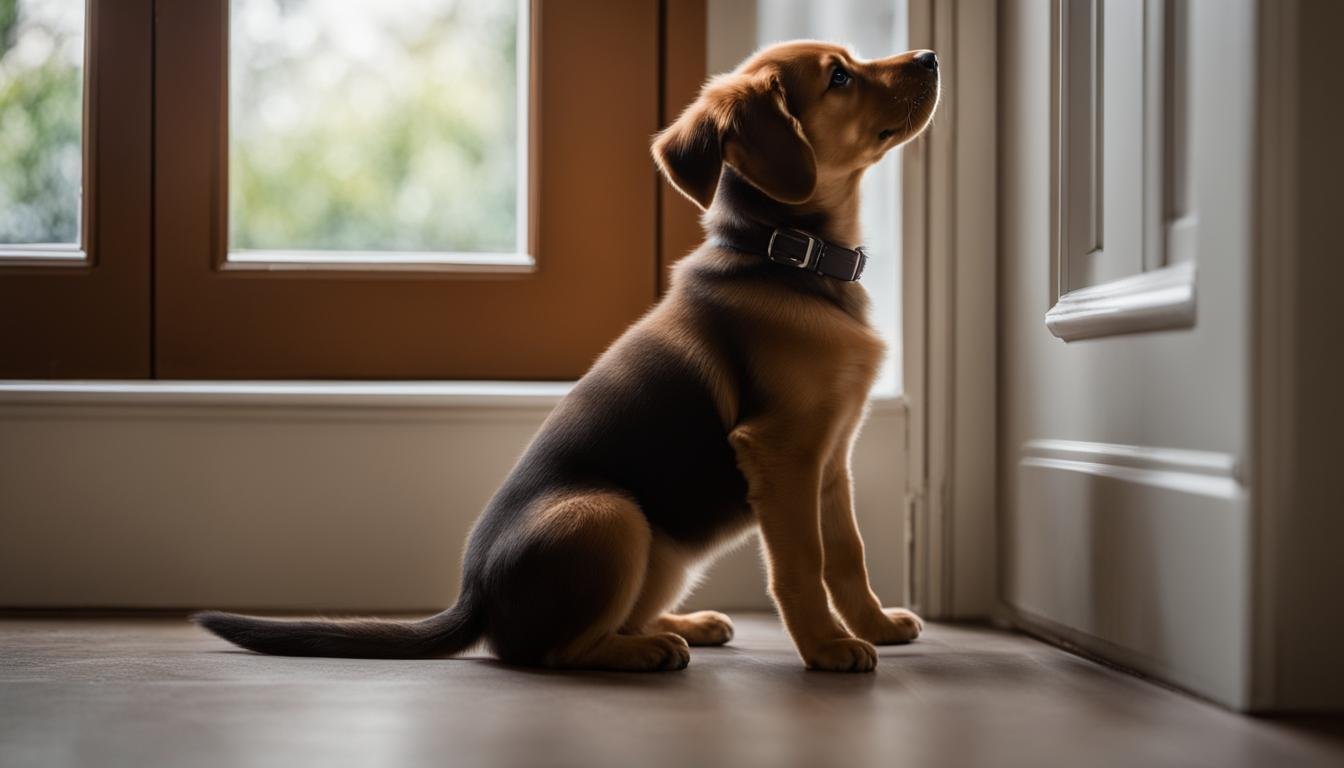
Table: Common Potty Cues in Puppies
| Potty Cue | Description |
|---|---|
| Pawing at the door | Scratching or tapping at the door to signal the need to go outside. |
| Whining or whimpering | High-pitched sounds indicating discomfort or the need for attention. |
| Restlessness or pacing | Walking or moving around anxiously, unable to settle. |
| Circling or sniffing the floor | Walking in circles and sniffing the ground, searching for a place to eliminate. |
| Suddenly stopping play | Interrupting an ongoing play session to indicate the need to go potty. |
Take Them Outdoors for Potty Training
When it comes to house training your puppy without a crate, taking them outdoors is a crucial part of the process. By designating a specific potty spot in your yard and using a potty command, you can effectively teach your puppy where to eliminate. Always remember to use a leash when taking your puppy outside for potty training to ensure their safety.
Once outside, give your puppy some time to sniff around and explore the designated potty spot. This allows them to become familiar with the area and encourages them to eliminate. Be patient and wait for your puppy to do their business. Using a potty command, such as “go potty,” can help associate the action with the command, making it easier for your puppy to understand what is expected.
It’s important to be prepared for different weather conditions when taking your puppy outdoors for potty training. Whether it’s sunny or raining, make sure you have the necessary equipment, such as an umbrella or raincoat, to keep both you and your puppy comfortable. Additionally, you can consider using potty bells or potty scents to further aid the potty training process and reinforce the desired behavior.
Remember, consistency is key when it comes to potty training your puppy. Take them outdoors to their designated potty spot regularly throughout the day, especially after meals and naps. By providing clear guidance and using positive reinforcement, you can help your puppy develop good potty habits and achieve successful crate-free house training.
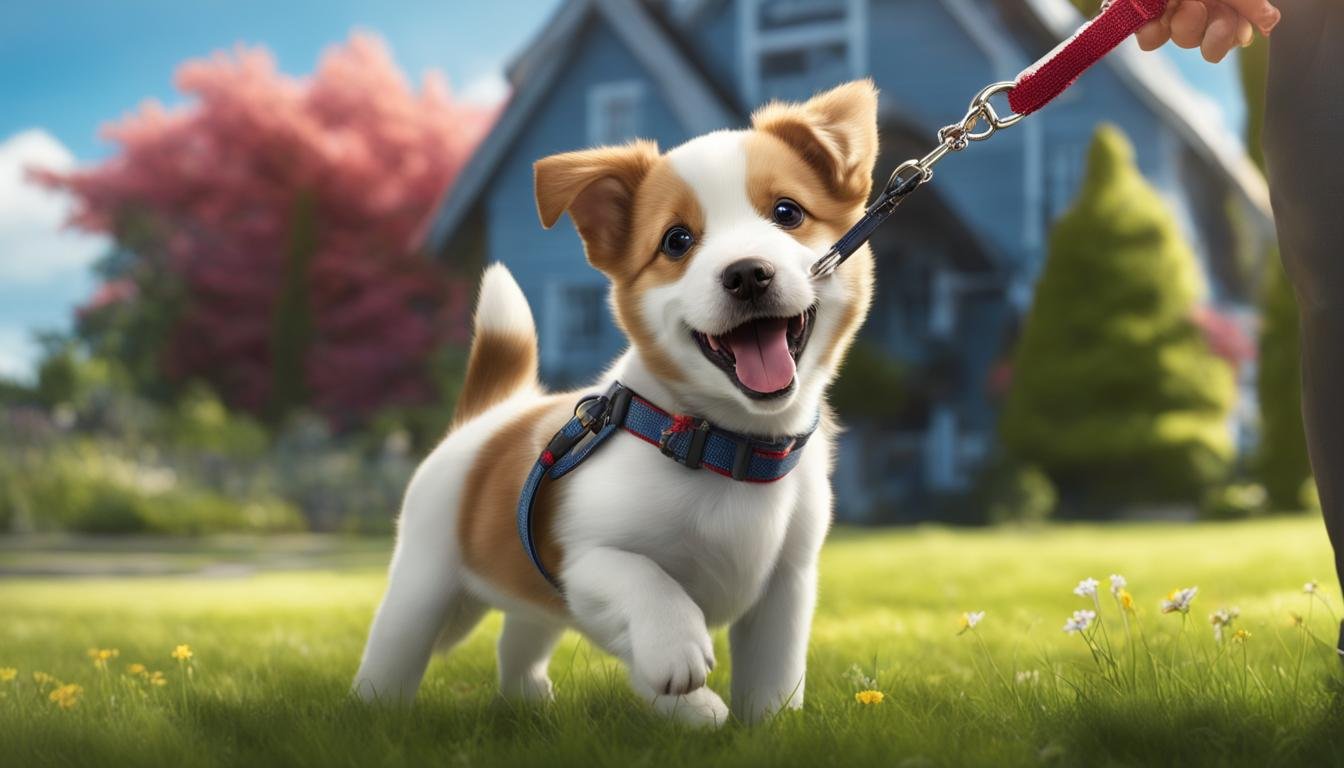
Table: Potty Training Outdoor Tips
| Tips | Description |
|---|---|
| Designate a specific potty spot | Choose an area in your yard where you want your puppy to eliminate consistently. This helps establish a routine and reinforces the behavior. |
| Use a potty command | Teach your puppy a specific command, such as “go potty,” to associate it with the action of eliminating. This helps your puppy understand what is expected when taken outdoors. |
| Be prepared for different weather conditions | Ensure you have the necessary equipment, such as an umbrella or raincoat, to keep both you and your puppy comfortable during potty training sessions. |
| Take your puppy out regularly | Establish a regular schedule for taking your puppy outdoors, especially after meals and naps. Consistency helps reinforce good potty habits. |
Nighttime Potty Training
When it comes to nighttime potty training, there are a few key strategies that can help set your puppy up for success. One important aspect is to limit your puppy’s water intake a few hours before bedtime. This will help reduce the chances of them needing to go potty during the night. By controlling their water intake, you can better predict when they will need to relieve themselves and plan accordingly.
To ensure your puppy doesn’t have any accidents during the night, it’s vital to take them out for a final potty break right before you go to bed. This will give them an opportunity to empty their bladder before settling down for the night. Gradually increasing the interval between nighttime potty breaks as your puppy grows older will help them develop better bladder control.
For younger puppies who are not yet able to hold their bladder throughout the night, you may want to consider setting up an alarm clock for a mid-night potty break. This will help prevent accidents and allow your puppy to learn the appropriate potty behavior. Additionally, placing their bed in your bedroom initially can provide a sense of security and make the transition to their own sleeping area smoother.
| Nighttime Potty Training Tips |
|---|
| Limit water intake a few hours before bedtime |
| Take your puppy out for a final potty break before bed |
| Gradually increase the interval between nighttime potty breaks |
| Consider setting up an alarm clock for mid-night potty breaks |
| Place their bed in your bedroom initially for security |
Clean Up Accidents Immediately
Accidents may happen during the house training process, especially when you’re training your puppy without a crate. It’s important to clean up accidents immediately to prevent your puppy from repeating the behavior and to keep your home clean and odor-free.
“Cleanliness is essential when it comes to house training a puppy without a crate. Accurate and prompt cleanup of accidents is crucial to reinforce the correct potty behavior and prevent your puppy from developing bad habits,” says Dr. Sarah Thompson, a veterinarian specializing in puppy training.
When accidents occur, use an enzymatic cleaner specifically designed for pet odors and stains. Regular household cleaners may not effectively eliminate the scent, which can attract your puppy to the same spot in the future. Enzymatic cleaners break down the odor-causing molecules and eliminate the scent completely. Make sure to thoroughly clean the affected area and surrounding carpets or furniture to remove any trace of the accident.
To keep the area odor-free and discourage your puppy from eliminating in the same spot again, consider using a pet deterrent spray. These sprays emit a scent that dogs find unpleasant, helping to prevent them from returning to the area. Additionally, keeping the area clean and odor-free will reinforce the desired potty behavior and make your puppy more likely to choose the designated potty spot.
| Accident Cleanup Tips |
|---|
| Act quickly and clean up accidents immediately to prevent your puppy from repeating the behavior. |
| Use an enzymatic cleaner specifically designed for pet odors and stains to eliminate the scent completely. |
| Thoroughly clean the affected area and surrounding carpets or furniture to remove any trace of the accident. |
| Consider using a pet deterrent spray to discourage your puppy from returning to the same spot. |
| Maintain a clean and odor-free environment to reinforce the desired potty behavior. |
Stay Consistent and Patient
Consistency is key when house training a puppy without a crate. Accidents may occur, especially during the initial stages of training, but with consistent cleanup and reinforcement of the desired potty behavior, your puppy will learn and adapt. Remember to stay patient and avoid punishment, as positive reinforcement is the most effective way to guide your puppy towards successful house training.
Stay Positive and Avoid Punishment
When it comes to crate-free puppy house training, maintaining a positive mindset is vital. Punishment can have negative effects on your puppy’s learning process and can lead to fear, anxiety, and a strained relationship. Instead, focus on positive reinforcement to encourage good behavior.
Rewards are an effective way to motivate your puppy and reinforce the desired actions. When your puppy eliminates in the designated potty area, praise them enthusiastically, offer treats, and give them a nice belly rub. This positive experience will create a strong association between the desired behavior and rewards, making them more likely to repeat it.
It’s important to remember that accidents will happen during the house training process. If you catch your puppy in the act of eliminating indoors, calmly interrupt them with a firm “no” and immediately take them outside to their designated potty spot. Avoid scolding or punishing your puppy, as it can create fear and confusion.
“Stay positive throughout the house training process and avoid punishing your puppy for accidents.”
Consistency is key in reinforcing positive behavior. Stick to a routine that includes regular potty breaks, feeding times, and rewards. By providing a structured and positive environment, you can help your puppy learn quickly and develop good habits.
Consistency is Key in House Training a Puppy Without a Crate
When it comes to house training a puppy without a crate, consistency is the key to success. By sticking to a routine and establishing clear guidelines, you can effectively teach your puppy where and when to eliminate. Consistency ensures that your puppy understands what is expected of them and helps them develop good habits.
One important aspect of consistency is establishing a regular feeding schedule. Feed your puppy at the same times each day, providing them with the right amount of food based on their age and size. This helps regulate their digestive system and makes it easier to predict when they will need to go potty.
Another key element of consistency is scheduling regular potty breaks. Take your puppy outside to their designated potty spot at regular intervals throughout the day. This could be first thing in the morning, after meals, and before bedtime. By following a consistent potty schedule, you are setting your puppy up for success and minimizing accidents indoors.
In addition to feeding and potty schedules, consistency also applies to your reactions and responses. Stay positive and avoid punishing your puppy for accidents. Instead, focus on rewarding good behavior and providing lots of praise and encouragement when they eliminate it in the correct spot. Consistency in your approach helps your puppy understand what is expected of them and reinforces the desired potty habits.
Benefits of Consistency in Puppy House Training
Consistency in crate-free puppy house training offers several benefits. It helps your puppy understand the routine and establish a sense of predictability. This can reduce anxiety and confusion, making the training process smoother for both you and your puppy. Consistency also builds trust between you and your puppy, as they learn to rely on you for guidance and support.
By staying consistent in your house training methods, you can effectively communicate with your puppy and create a positive learning environment. This consistency helps them understand the right place and time to eliminate, leading to a cleaner and more harmonious living space. Remember, each puppy is unique and may require slightly different approaches, so adapt your training methods as needed while still maintaining overall consistency.
| Benefits of Consistency in Puppy House Training |
|---|
| Establishes routine and predictability |
| Reduces anxiety and confusion |
| Builds trust between you and your puppy |
| Creates a positive learning environment |
| Leads to a cleaner and more harmonious living space |
Consistency is key in crate-free puppy house training. By maintaining a consistent routine, setting clear guidelines, and providing positive reinforcement, you can effectively teach your puppy where and when to eliminate. With time and patience, your puppy will develop good potty habits and enjoy a harmonious living environment with you.
Conclusion
In conclusion, house training a puppy without a crate is a realistic and achievable goal. By implementing the strategies outlined in this guide, you can successfully teach your puppy to eliminate in the appropriate areas without the need for a crate.
Preparing your home and establishing a consistent routine are essential steps in the process. Puppy-proofing your living space and creating a designated potty area will help set your puppy up for success. Additionally, sticking to a consistent feeding schedule and scheduling regular potty breaks will reinforce positive potty habits.
Remember, consistency and positive reinforcement are key. By providing rewards and praise for good behavior and avoiding punishment for accidents, you can create a positive environment for your puppy to learn and grow. With patience and persistence, you and your puppy can enjoy a harmonious and mess-free future together.
FAQ
Is crate-free puppy house training effective?
Yes, crate-free puppy house training can be just as effective as crate training. It offers convenience, freedom, and bonding opportunities for both you and your puppy.
How do I prepare my home for crate-free puppy house training?
Puppy-proof your living space by removing potential hazards, cleaning up previous potty spots, and blocking off areas you don’t want your puppy to access with baby gates.
What is the importance of establishing a consistent feeding schedule?
A consistent feeding schedule helps regulate your puppy’s potty schedule. Feed them at the same times each day and provide the right amount of food based on their age, size, and breed.
How often should I take my puppy outside for potty breaks?
Take your puppy outside first thing in the morning, after meals, and before bedtime. Younger puppies may need to go every few hours, while older ones can hold it for longer.
What are the signs that my puppy needs to go potty?
Look out for signs such as pawing at the door, whining, restlessness or pacing, circling or sniffing the floor, and suddenly stopping play. Take your puppy outside immediately when you notice these behaviors.
How do I potty train my puppy outdoors?
Use a leash and take your puppy to a designated potty spot in your yard every time. Give them time to sniff around and use a potty command to associate the action with the command.
How can I ensure successful nights during the house training process?
Limit your puppy’s water intake a few hours before bedtime, and take them out for a final potty break before you go to bed. Consider setting up an alarm for a mid-night potty break for younger puppies.
How should I clean up accidents during house training?
Clean up accidents immediately using an enzymatic cleaner to eliminate lingering odors. Keeping the area clean and odor-free will help reinforce the correct potty behavior.
Should I punish my puppy for accidents during house training?
No, it’s important to stay positive and avoid punishment. Use positive reinforcement, such as treats and praises, to reward your puppy for eliminating in the right spot.
How important is consistency in puppy house training?
Consistency is key in creating good habits. Stick to the established routine, including feeding, potty breaks, and rewards. With time and persistence, your puppy will learn the appropriate potty behavior.



